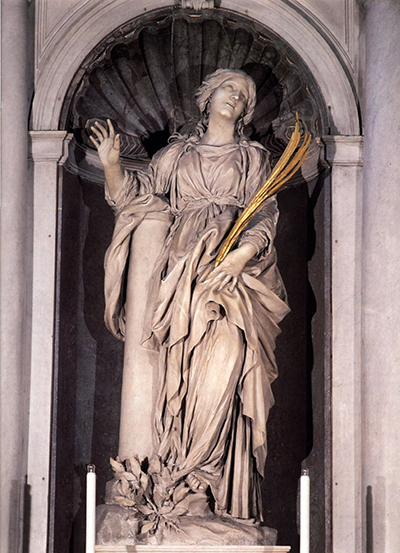The statue of Saint Bibiana stands as the first example of Christian Baroque type. By the rediscovering of Saint Bibiana's body at the start of Urban VIII pontificate, this sculpture was commissioned in 1624.
The pontificate was considered a good sign of the start of Urban VIII papacy. Hence, he launched the rebuilding of the initial church in the Baroque style. In addition to the building structure, a new high altar of the Saint Bibiana and an interior was created. Execution of the sculpture and building works was commissioned to Bernini. Bernini received the first payment for his work in 1624 and the final payment in 1626.
The statue of Saint Bibiana is shaped like a standing female figure wrapped in a robe along her palm branches and attributes column. The nature of this work is based on the expressions and gestures of Saint Bibiana. Her mouth is open, and she is viewing the skies, evoking emotional face conflict. One of her hands grips the palm branch in calm, while the other hand gently lies on the column with the forearm in front, depicting resistance to the story.
The statue does not indicate the particular point of Bibiana's life, but only an abstract story characterised figure. It is, however, possible to see Saint Bibiana`s emotions and her illusive allegiance. The statue is set in a recess of the altar at the end of the church. The creation of a new unique window above the altar brings a bright glow of light, supporting the mystical feeling of the scene.
This statue has a cartouche at the top inscribed; 'ALTARE PRIVILEGIATVM/ PERPETVVM.' and at the base; 'S. BIBIANÆ V. ET M./ SIMVLACRVM AB EQ.E IO.LAVR.BERNINO'. Below the sculpture is an inscription; 'VRBANVS P.P.VIII ... MDCXXVI PONT. IIII.' while at the bottom right: 'Rome ex Officina Io Iacobi de Rubeis ad Temp SM de Pace cum Priv S. Pont.'
Baroque is a highly ornate type of architecture, music, and art. It flourished in Europe during the early 17th to the mid-18th century. Baroque style followed the Renaissance system and preceded the Neoclassical and the Rococo (sometimes referred to as the "late Baroque") styles. The Catholic Church promoted this style as a way to counter the austerity and simplicity of Protestant architecture, music, and art. However, Lutheran Baroque art also advanced in some parts of Europe. The Baroque style used movement, contrast, exuberant detail, grandeur, deep colour, and surprise to attain a sense of awe.
Saint Agnes statue which was inspired by one of Lorenzo`s models and created during the third quarter of the 17th century. It was designed in bronze. Another famous piece related to this is the Bacchanal: A Faun Teased by Children. Lorenzo created it in marble during ca. 1616–17.
The sculpture was one of the large Bernini retrospectives shown at the Galleria Borghese in Rome. During its return to the Santa Bibiana church, the ring finger of Saint Bibiana's right hand got broken off. The sculpture currently stands in the high altar of Santa Bibiana church in Rome. There is also a seventeenth-century print of this statue in the Teylers Museum, Harlem, the Netherlands.




